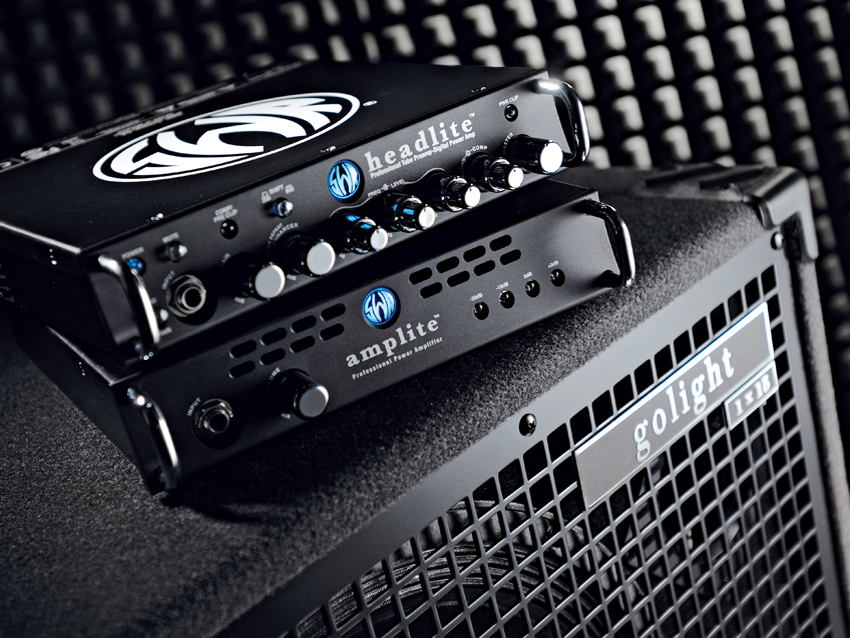MusicRadar Verdict
For players on the move, this is another fantastic portable and powerful option. The Amplite as an optional extra is certainly an attractic proposition, if a little pricey.
Pros
- +
Size and weight. Sounds. Great tonal variation.
Cons
- -
Crowded control panel. Indicator dots very hard to see.
MusicRadar's got your back

Headlite, Amplite and Golight.

SWR front view

SWR close-up
As the bass amplification market continues to focus on getting a bigger punch from smaller units, SWR has been one of the few to resist the trend - until now.
Yet, in a way, SWR started the downsizing trend with the famous Redhead combo, so why the delay in going all the way? Quite simply, SWR has taken the time to make sure that its Class D would offer sounds and quality equal to its current conventionally sized ranges, and that's a process that couldn't be rushed.
"If you're happy with the natural sound of your bass, using just the Amplite connected to the speaker works fine. We tried it with a Fender Precision and it sounded superb."
To achieve this, SWR has produced a system that uses separate preamp, power amp and speaker units. Everything is ultra-compact and lightweight, yet the performance quality is truly excellent.
Either the preamp or the power amp can be connected to the speaker, or you can go through one and into the other before the speaker. Both amplifier units are fan-cooled and can be rack-mounted using the optional conversion kit if required.
Headlite
For the ultimate in portability, using just this and the cabinet is the way to go. Well endowed, the controls include aural enhancement and compression, with each tone rotary offered in dual-concentric configuration of frequency and volume.
This is a most versatile form of tonal blending with centre detent nailing the flat response. A fourth dual pot services compression and effects blending. A handy indicator light flashes orange when compression is engaged, and shows red when the input signal is being clipped.
This Headlite package includes a padded gig bag that can also house the Amplite, optional footswitch and cables.
Amplite
Neatly offered in the same size as the Headlite, there's little to see here, just a single volume control and four LEDs that constitute a level meter.
It's used to boost the sound when using more than one cabinet and the linking facilities are all at the rear. However, if you're perfectly happy with the natural sound of your bass guitar, then using just this connected to the speaker will work fine. We tried it with a trusty Fender Precision and it sounded superb.
Golight 1 x 15
This particular Golight full- range cabinet offers a single 15-inch driver plus a horn/tweeter for some additional note clarity and projection, so is suitable for any style of playing.
Front-ported and incredibly light, it comes covered in black felt with plastic corner protectors all round and a square mesh metal front grille. It has side-located 'door knocker'-type handles and proves to be a comfortable one-man lift.
The rear panel offers a horn level control, plus input and output sockets for daisy chaining speakers in both speakon and standard jack socket options.
Sounds
Adding the Amplite into the equation merely provides more power, so we're concentrating on the Headlite into the Golight cabinet here.
The Headlite may have only three areas for tonal alteration, but the ability to shift frequency and intensity gives enormous variation. The low end is huge, while the top end provides definition and punch in that particular SWR fashion.
In addition, the aural enhancer quickly presents the player with a variety of EQ sound imprints, or simply push the control to revert to flat response that will favour electro-acoustic instruments.
Effects blending is good and the compressor provides an even sound across the strings but is subtle, so don't expect to use it as a sound feature.
Overall
Being so compact and relatively well endowed with sound options, operating the preamp is a bit fiddly, but this is a small price to pay when the results are this good.
Also, to get full power from either or both of the amplifying units you'll need two cabinets to achieve full impedance matching. However, using the Headlite alone or with the Amplite, you can be assured that the classic SWR sound imprint stays intact. Using the Amplite alone will favour your bass's pure natural sound, or whatever preamp you may choose to link it to.
Staying SWR all the way, however, is likely to offer optimum performance. It's been a while coming, but it's worth the wait.
Learn production, DJing and songwriting from pros like Fraser T Smith, Carl Cox, Skream and Joe Goddard with Whatclass
Native Instruments’ Kontrol S MK3 MIDI keyboards just added several features that DAWless music producers have been asking for
“You're by far the best guy that we've tried. I would love to have you in the band”: So why did Trent Reznor turn down Richie Kotzen for Nine Inch Nails?










